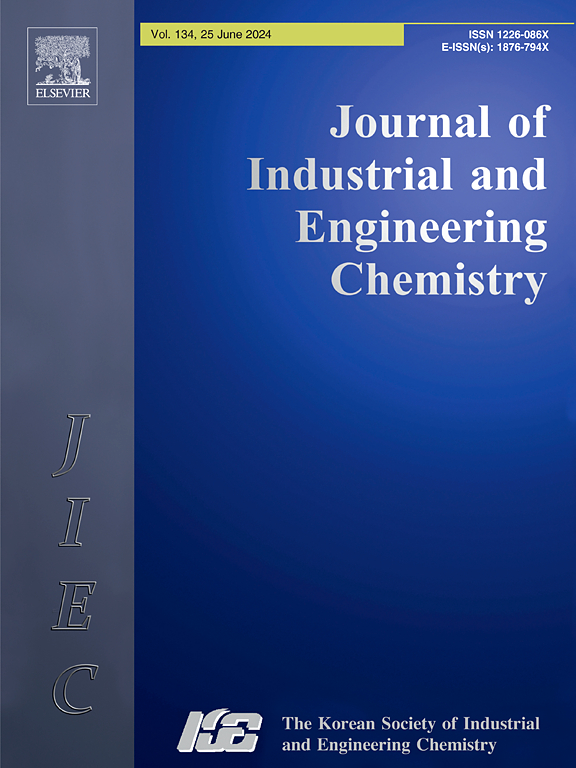Electrocatalytic CO2 reduction over Ag/CuSn Electrodes: Modulation of C1, C2, and C3+ products
IF 5.9
3区 工程技术
Q1 CHEMISTRY, MULTIDISCIPLINARY
Journal of Industrial and Engineering Chemistry
Pub Date : 2024-11-17
DOI:10.1016/j.jiec.2024.11.032
引用次数: 0
Abstract
Combining different metals has proven to be an effective methodology for fabricating electrodes that can manipulate reduction products in electrochemical (EC) CO2 reduction. In this study, CuSn and EC treated CuSn were surface-modified with Ag via sputter deposition. EC CO2 reduction was performed at various applied potentials in KHCO3, K2CO3, and KOH electrolytes. The effects of cations and anions were tested to examine the variation in reduction products. The major reduction products were H2 and C1 compounds (CO, CH4, formate), as well as C2 compounds (C2H4, ethanol, and acetate). Minor products included C1 compounds (methanol), C2 compounds (acetaldehyde and glycolaldehyde), and C3+ compounds (propanol and isopropanol), along with C2H6 and C3+ hydrocarbon products. The variation of C2+ hydrocarbons was explained by Fischer-Tropsch (F-T) chemistry. The oxidation states of Cu and Sn, as well as the Cu/Sn ratios, were examined before and after EC CO2 reduction using depth-profiled X-ray photoelectron spectroscopy. The experimental factors—catalyst composition, applied potential, and electrolyte composition—interacted to create a complex reaction environment. This combined approach provides valuable insights into identifying optimal conditions for achieving desired product selectivity.

Ag/CuSn电极上的电催化CO2还原:C1, C2和C3+产物的调制
事实证明,在电化学(EC)还原二氧化碳的过程中,将不同的金属结合在一起是制造可操控还原产物的电极的有效方法。在这项研究中,通过溅射沉积,用银对 CuSn 和 EC 处理过的 CuSn 进行了表面修饰。在 KHCO3、K2CO3 和 KOH 电解质中,以不同的应用电位进行了电化学二氧化碳还原。测试了阳离子和阴离子的影响,以检验还原产物的变化。主要还原产物是 H2 和 C1 化合物(CO、CH4、甲酸盐)以及 C2 化合物(C2H4、乙醇和乙酸盐)。次要产物包括 C1 化合物(甲醇)、C2 化合物(乙醛和乙醛)、C3+ 化合物(丙醇和异丙醇)以及 C2H6 和 C3+ 碳氢化合物产物。C2+ 碳氢化合物的变化可以用费托化学(F-T)来解释。使用深度剖面 X 射线光电子能谱对 EC CO2 还原前后铜和锡的氧化态以及铜/锡比率进行了研究。实验因素--催化剂成分、外加电位和电解质成分--相互作用,创造了一个复杂的反应环境。这种综合方法为确定实现理想产品选择性的最佳条件提供了宝贵的见解。
本文章由计算机程序翻译,如有差异,请以英文原文为准。
求助全文
约1分钟内获得全文
求助全文
来源期刊
CiteScore
10.40
自引率
6.60%
发文量
639
审稿时长
29 days
期刊介绍:
Journal of Industrial and Engineering Chemistry is published monthly in English by the Korean Society of Industrial and Engineering Chemistry. JIEC brings together multidisciplinary interests in one journal and is to disseminate information on all aspects of research and development in industrial and engineering chemistry. Contributions in the form of research articles, short communications, notes and reviews are considered for publication. The editors welcome original contributions that have not been and are not to be published elsewhere. Instruction to authors and a manuscript submissions form are printed at the end of each issue. Bulk reprints of individual articles can be ordered. This publication is partially supported by Korea Research Foundation and the Korean Federation of Science and Technology Societies.

 求助内容:
求助内容: 应助结果提醒方式:
应助结果提醒方式:


